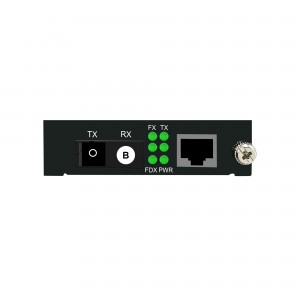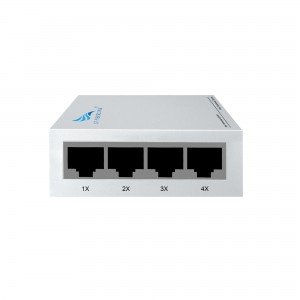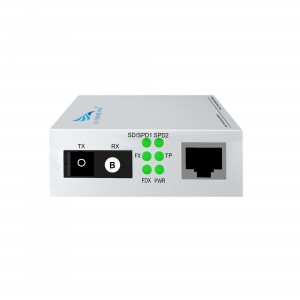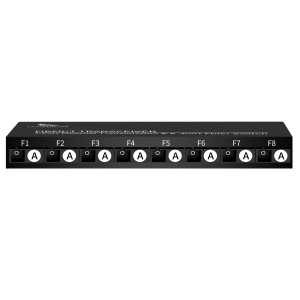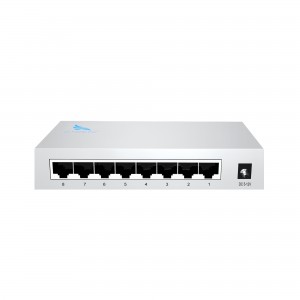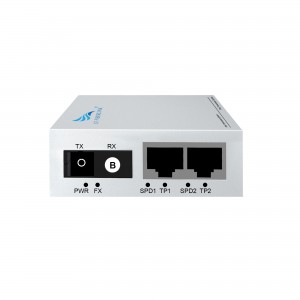4-port 10/100/1000M Media Converter (Single-mode Dual-fiber SC)
4-port 10/100/1000M Media Converter (Single-mode Dual-fiber SC)
Product Features:
Introducing the Gigabit 2 Optical 2 Electrical Single Mode Dual Fiber Transceiver: Unparalleled Connectivity for Your Data Center
Huizhou Changfei Optoelectronics Technology Co., Ltd., an innovative high-tech company specializing in various cutting-edge communication equipment, has launched its latest product lineup – Gigabit 2 optical 2 electrical single-mode dual-fiber transceivers. Designed for the demanding requirements of data center environments, this rugged fiber optic transceiver is ideal for seamless Fiber-to-Ethernet switching.
With the continuous development of technology, the demand for high-speed data transmission in data centers has become more and more important. With the Gigabit 2 Optical 2 Electrical Single Mode Dual Fiber Transceiver you can ensure lightning fast and reliable connections to keep your data center running at peak performance.
Featuring an SC interface connector, the transceiver is seamlessly compatible with a wide variety of optical devices, allowing for easy integration into your existing infrastructure. The iron case design provides strong protection against physical damage, ensuring the longevity and durability of the device.
One of the main highlights of this transceiver is its low power consumption. By using electricity efficiently, you can significantly reduce energy costs and contribute to a greener, more sustainable environment. Plus, 4-digit dial codes are easy to configure and manage, ideal for IT professionals looking to simplify operations.
Gigabit 2 optical 2 electrical single-mode dual-fiber transceivers are tailored to meet the diverse needs of data centers. Its high-speed performance combined with its rugged construction enables seamless data transfer even in the most demanding environments. Whether you are looking to upgrade an existing network or build a new data center, this transceiver provides outstanding performance and reliability.
At Huizhou Changfei Photoelectric Technology Co., Ltd., we are committed to providing innovative and reliable solutions for your network needs. With a wide range of products, including industrial-grade cloud-managed switches, smart PoE switches, and optical modules, we strive to be a one-stop destination for all your networking needs.
Our expert team is dedicated to providing excellent customer service and technical support. We understand the critical role communication plays in today’s fast-paced business environment, and we are committed to ensuring our products meet and exceed your expectations.
In conclusion, the Gigabit 2-optical 2-electrical single-mode dual-fiber transceiver is the perfect choice for data center operators looking to enhance network performance. Packed with advanced features including SC interface connectors, steel housing design, low power consumption, and easy configuration, this ruggedized transceiver ensures uninterrupted connectivity, delivering unmatched speed and reliability for your data center.
Choose Huizhou Changfei Optoelectronics Technology Co., Ltd. as your trusted network solution partner. Contact us today to learn more about our products and how they can benefit your business. Let us help you revolutionize data center connectivity!
What This Product Does
◇ The CF-2022GSW-20 is a media converter designed to convert 1000BASE-X fiber to 1000Base-T copper media or vice versa. Designed under IEEE802.3ab 1000Base-T and IEEE802.3z1000Base-X standards, the CF-2022GSW-20 is designed for use with single-mode fiber cable utilizing the SC-Type connector. The CF-2022GSW-20 supports longwave laser specification at a full wire speed forwarding rate. It works at 1310nm on both transmitting and receiving data.
◇ Other features of this module include the ability to be used as a stand alone device (no chassis required), Auto MDI/MDI-X for TX port, and front panel status LEDs. The CF-2022GSW-20 will transmit at extended fiber optic distances utilizing single-mode fiber up to 20 kilometers.
Other Features
◇ In addition, the media converter can be used as a standalone device for automatic MDI/MDI-X in the TX port, where duplex mode is automatically negotiated.
Technical Parameter:
|
Model |
CF-2022GSW-20 | |
| Interface Characteristics | ||
|
Fixed Port |
2* 10/ 100/ 1000Base-T RJ45 port 2* 1000Base-X uplink SC fiber port |
|
|
Ethernet Port |
10/ 100/ 1000Base-T auto-sensing, full/half duplex MDI/MDI-X self-adaption |
|
|
Twisted Pair Transmission |
10BASE-T: Cat3,4,5 UTP(≤100 meter) 100BASE-T: Cat5e or later UTP(≤100 meter) 1000BASE-T : Cat5e or later UTP(≤100 meter) |
|
| Optical Port | Default optical module is single-mode dual-fiber 20km, SC port | |
| Wavelength/Distance | single mode: 1310nm 0~40KM ,1550nm 0~120KM | |
| Chip Parameter | ||
| Network Protocol | IEEE802.3 10BASE-T, IEEE802.3i 10Base-T,
IEEE802.3u 100Base-TX, IEEE802.3u 100Base-FX, IEEE802.3x IEEE802.3ab 1000Base-T;IEEE802.3z 1000Base-X; |
|
|
Forwarding Mode |
Store and Forward(Full Wire Speed) |
|
|
Switching Capacity |
8Gbps |
|
|
Buffer Memory |
5.95Mpps | |
|
MAC |
2K | |
|
LED Indicator |
Fiber | Fiber1/Fiber2 |
| Data | 1X/2X (green) | |
| Power | PWR (green) | |
| Power | ||
| Working Voltage |
AC:100-240V |
|
|
Power Consumption |
Standby<1W, Full load<5W |
|
|
Power Supply |
DC:5V/2A industrial power supply |
|
| Lightning protection &Certification | ||
| Lightning protection | Lightning protection: 4KV 8/20us, Protection level: IP30 | |
| Certification | CCC;CE mark, commercial; CE/LVD EN60950;FCC Part 15 Class B; RoHS | |
| Physical Parameter | ||
| Operation TEMP | -20~+55°C;5%~90% RH Non condensing | |
| Storage TEMP |
-40~+85°C;5%~95% RH Non condensing |
|
| Dimension (L*W*H) | 88mm* 71mm*27mm | |
| Installation | Desktop | |
Product Size:
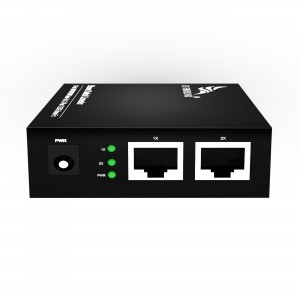
product application diagra:

How to choose a fiber optic transceiver?
Optical fiber transceivers break the 100-meter limitation of Ethernet cables in data transmission. Relying on high-performance switching chips and large-capacity caches, while truly achieving non-blocking transmission and switching performance, they also provide balanced traffic, isolation and conflict. Error detection and other functions ensure high security and stability during data transmission. Therefore, fiber optic transceiver products will still be an indispensable part of actual network construction for a long time. So, how should we choose fiber optic transceivers?
1. Port function test
Mainly test whether each port can work normally in the duplex state of 10Mbps, 100Mbps and half-duplex state. At the same time, it should be tested whether each port can automatically select the highest transmission speed and automatically match the transmission rate of other devices. This test can be included in other tests.
2. Compatibility test
It mainly tests the connection ability between the optical fiber transceiver and other devices compatible with Ethernet and Fast Ethernet (including network card, HUB, Switch, optical network card, and optical switch). The requirement must be able to support the connection of compatible products.
3. Cable connection characteristics
Test the fiber optic transceiver’s ability to support network cables. First, test the connection ability of Category 5 network cables with lengths of 100m and 10m, and test the connection ability of long Category 5 network cables (120m) of different brands. During the test, the optical port of the transceiver is required to have a connection capability of 10Mbps and a rate of 100Mbps, and the highest must be able to connect to a full-duplex 100Mbps without transmission errors. Category 3 twisted pair cables may not be tested. Subtests can be included in other tests.
4. Transmission characteristics (transmission loss rate of data packets of different lengths, transmission speed)
It mainly tests the packet loss rate when the optical fiber transceiver optical port transmits different data packets, and the connection speed under different connection rates. For the packet loss rate, you can use the test software provided by the network card to test the packet loss rate when the packet size is 64, 512, 1518, 128 (optional) and 1000 (optional) bytes under different connection rates. , the number of packet errors, the number of packets sent and received must be more than 2,000,000. Test transmission speed can use perform3, ping and other software.
5. The compatibility of the whole machine to the transmission network protocol
It mainly tests the compatibility of fiber optic transceivers to network protocols, which can be tested in Novell, Windows and other environments. The following low-level network protocols such as TCP/IP, IPX, NETBIOS, DHCP, etc. must be tested, and the protocols that need to be broadcast must be tested. Optical transceivers are required to support these protocols (VLAN, QOS, COS, etc.).
6. Indicator status test
Test whether the status of the indicator light is consistent with the description of the panel and the user manual, and whether it is consistent with the current status of the fiber optic transceiver.








